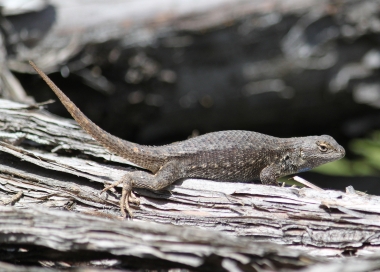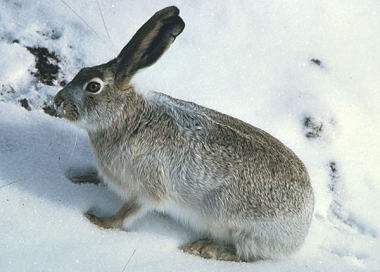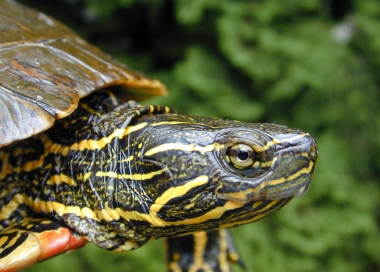
Watch wildlife with purpose
Join the community scientists who have shared their wildlife observations in Oregon throughout the iNaturalist app. Record your sightings of mammals, birds, amphibians and reptiles from around the state and contribute valuable data to wildlife conservation.

ODFW is charged with protecting and enhancing the state’s wildlife populations, but ODFW staff can’t be everywhere. That’s why we’re asking Oregonians to help us document the presence and distribution of different wildlife species across the state.
So, next time you’re out hunting, fishing, hiking, kayaking or otherwise exploring Oregon, take photos or record sounds of the animals you see and share them with us.
Use iNaturalist to identify and record the animals you see
The iNaturalist app is both a nature and social app. When you download the app and start recording your observations, you join thousands of fellow community scientists who have already documented wildlife in Oregon. When users choose to add their observations in iNaturalist to the Oregon Wildlife Conservation project, they help us better understand Oregon wildlife species and their habitat requirements.
ODFW can use information gathered throughout the Oregon Wildlife Conservation project in its research efforts, conservation plans and management actions to help protect sensitive species. ODFW biologists have used data provided by iNaturalist users to help inform planning for surveys to document the current distribution of Strategy Species, and the Oregon Connectivity Assessment and Mapping Project (OCAMP) has used iNaturalist data to help validate habitat connectivity maps.
If you want to share data with ODFWs Conservation Program, it's important to add your iNaturalist data to the Oregon Wildlife Conservation project. iNaturalist automatically obscures the locations of observations for some species that may be at risk from disturbance if their location was publicly available, such as the northern red-legged frog or western snowy plover. When you add your data to the project, the location information becomes available to ODFW biologists.
What to look for
While we’re interested in all wildlife observations, we’re particularly interested in your observations of the 109 wildlife Strategy Species included in the Oregon Conservation Strategy, which includes 17 amphibians, 58 birds, 29 mammals and five reptiles.
The Oregon Conservation Strategy is a blueprint for conservation in Oregon that brings together the best available scientific information, and presents a menu of recommended voluntary actions and tools for all Oregonians to define their own conservation role.
Make sure to document where you’re taking the photo using a map, your phone's geotagging capability or a GPS. You don’t need to know what animal you’ve seen before you upload your observation – in fact, iNaturalist is a great tool to learn how to identify new species. Plus, the iNaturalist community may be able to help you identify your photo. While the Oregon Wildlife Conservation project is specifically focused on wildlife species, don’t let that stop you from documenting all living things around you. There are many other iNaturalist projects in Oregon that would benefit from your observations of other taxa.
Capture and upload images
The following step-by-step guide will show you how to use the community-science platform, iNaturalist, and how to share your wildlife observation data with the Oregon Wildlife Conservation project.
|
|
|
|
| Wildlife such as the northern sagebrush lizard, white-tailed jackrabbit and the western painted turtle are hard to find in Oregon but through iNaturalist you can help ODFW biologists learn more about them. | ||
1) Join iNaturalist & download the free app.
Navigate to the iNaturalist website, click on “Sign up” and follow the instructions to create an iNaturalist account.
Don’t forget to download the app for adding observations with a mobile device in the field.
- For Apple devices.
- For Android devices.
If you’re just beginning with iNaturalist, there is a helpful guide available on their getting started page.
2) Join the Oregon Wildlife Conservation project on iNaturalist.
Once you’ve created an iNaturalist account, go to ODFW’s Wildlife Conservation project.
Click “Join this project” in the upper right corner.
3) Discover Oregon’s Strategy Species.
Look through the Oregon Wildlife Conservation project and see what wildlife species others already have documented. You can learn about where wildlife species are being seen around Oregon, and you may even be able to help someone else identify an animal they’ve recorded.
4) Upload your observations to iNaturalist, add them to Oregon Wildlife Conservation.
For guidance on how to add new observations to iNaturalist, see iNaturalist guidance for
the mobile app and desktop application.
You can add data to the “Oregon Wildlife Conservation” project each time you upload an observation.
5) Import your existing data
If you have several observations already in iNaturalist, please see “How to import your existing iNaturalist wildlife observations into the Oregon wildlife conservation project” (PDF) for instructions on how to do a batch edit to add all of your suitable observations to this project. Make sure you join the project before you try to add your data.
The Oregon Wildlife Conservation project will collate data that can be used for years to come. So, get out there and visit Oregon’s forests, meadows and peaks, rivers and streams, and help document where these species are living. It’s an important mission and we can’t do it alone!
Header image of an American pika by Keith Kohl.






